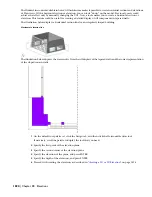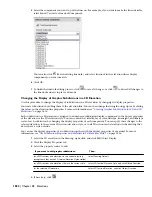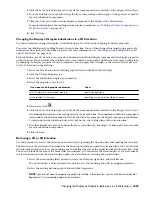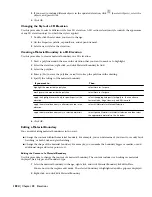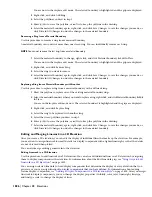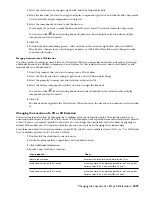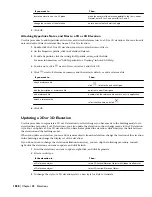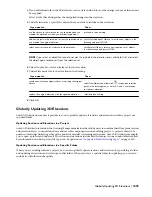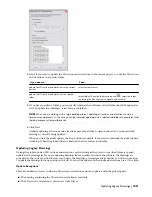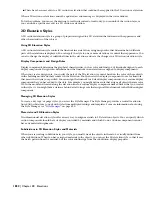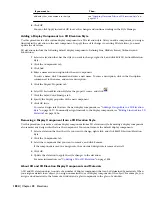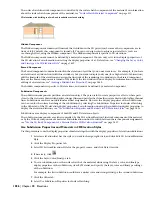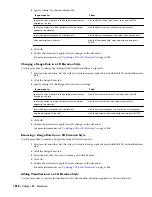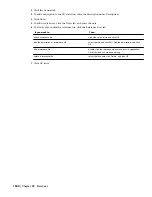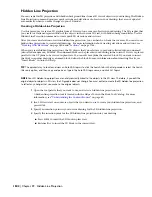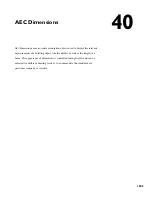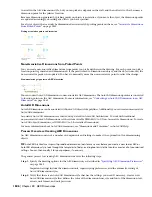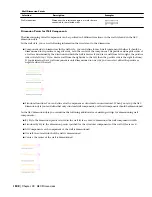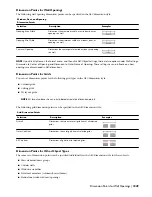
Then…
If you want to…
see
“
Attaching Notes and Files to a 2D Elevation Style
” on
page 1839
.
add notes, files, or documents to the style
6
Click OK.
You can click Apply instead of OK to save the changes and continue working in the Style Manager.
Adding a Display Component to a 2D Elevation Style
Use this procedure to add a custom display component to a 2D elevation style. After you add a component, you assign
linework in the elevation to the new component. To apply these style changes to existing 2D elevations, you must
update the elevation.
2D elevations include the following default display components: Defining Line, Hidden, Erased, Unknown, and
Subdivision.
1
Select an elevation that has the style you want to change, right-click, and click Edit 2D Section/Elevation
Style.
2
Click the Components tab
3
Click Add.
4
Enter a name and a description for the new component.
To enter a name, click Unnamed and enter a new name. To enter a description, click in the Description
column next to the name, and enter a description.
5
Click the Display Properties tab.
6
Select 2D Section/Elevation Style for the property source, and click
.
7
Click the Layer/Color/Linetype tab.
8
Specify the display properties of the new component.
9
Click OK twice.
To create a design rule that uses the new display component, see “
Adding a Design Rule to a 2D Elevation
Style
” on page 1837. To manually assign linework to the display component, see “
Editing Linework in a 2D
Elevation
” on page 1826.
Removing a Display Component from a 2D Elevation Style
Use this procedure to remove a custom display component from a 2D elevation style. Removing a display component
also removes any design rules that use the component. You cannot remove the default display components.
1
Select a elevation that has the style you want to change, right-click, and click Edit 2D Section/Elevation
Style.
2
Click the Components tab.
3
Select the component that you want to remove, and click Remove.
If the component is used in a design rule, the associated design rule is removed as well.
4
Click OK.
5
Update the elevation to apply the style changes to the elevation.
For more information, see “
Updating a 2D or 3D Elevation
” on page 1828.
About 2D and 3D Elevation Display Components and Materials
A 2D and 3D elevation object consists of a number of display components that can be determined by materials. When
you assign materials to an object, you assign one material to each display component of the object. For example, you
assign a wood material to the frame of a window and a glass component to the glass of a window.
1834 | Chapter 38 Elevations
Summary of Contents for 00128-051462-9310 - AUTOCAD 2008 COMM UPG FRM 2005 DVD
Page 1: ...AutoCAD Architecture 2008 User s Guide 2007 ...
Page 4: ...1 2 3 4 5 6 7 8 9 10 ...
Page 40: ...xl Contents ...
Page 41: ...Workflow and User Interface 1 1 ...
Page 42: ...2 Chapter 1 Workflow and User Interface ...
Page 146: ...106 Chapter 3 Content Browser ...
Page 164: ...124 Chapter 4 Creating and Saving Drawings ...
Page 370: ...330 Chapter 6 Drawing Management ...
Page 440: ...400 Chapter 8 Drawing Compare ...
Page 528: ...488 Chapter 10 Display System ...
Page 540: ...500 Chapter 11 Style Manager ...
Page 612: ...572 Chapter 13 Content Creation Guidelines ...
Page 613: ...Conceptual Design 2 573 ...
Page 614: ...574 Chapter 14 Conceptual Design ...
Page 678: ...638 Chapter 16 ObjectViewer ...
Page 683: ...Designing with Architectural Objects 3 643 ...
Page 684: ...644 Chapter 18 Designing with Architectural Objects ...
Page 788: ...748 Chapter 18 Walls ...
Page 942: ...902 Chapter 19 Curtain Walls ...
Page 1042: ...1002 Chapter 21 AEC Polygons ...
Page 1052: ...Changing a door width 1012 Chapter 22 Doors ...
Page 1106: ...Changing a window width 1066 Chapter 23 Windows ...
Page 1172: ...1132 Chapter 24 Openings ...
Page 1226: ...Using grips to change the flight width of a spiral stair run 1186 Chapter 25 Stairs ...
Page 1368: ...Using the Angle grip to edit slab slope 1328 Chapter 28 Slabs and Roof Slabs ...
Page 1491: ...Design Utilities 4 1451 ...
Page 1492: ...1452 Chapter 30 Design Utilities ...
Page 1536: ...1496 Chapter 31 Layout Curves and Grids ...
Page 1564: ...1524 Chapter 32 Grids ...
Page 1611: ...Documentation 5 1571 ...
Page 1612: ...1572 Chapter 36 Documentation ...
Page 1706: ...Stretching a surface opening Moving a surface opening 1666 Chapter 36 Spaces ...
Page 1710: ...Offsetting the edge of a window opening on a freeform space surface 1670 Chapter 36 Spaces ...
Page 1956: ...1916 Chapter 42 Fields ...
Page 2035: ...Properties of a detail callout The Properties of a Callout Tool 1995 ...
Page 2060: ...2020 Chapter 45 Callouts ...
Page 2170: ...2130 Chapter 47 AEC Content and DesignCenter ...
Page 2171: ...Other Utilities 6 2131 ...
Page 2172: ...2132 Chapter 48 Other Utilities ...
Page 2182: ...2142 Chapter 51 Reference AEC Objects ...
Page 2212: ...2172 Chapter 52 Customizing and Adding New Content for Detail Components ...
Page 2217: ...AutoCAD Architecture 2008 Menus 54 2177 ...
Page 2226: ...2186 Chapter 54 AutoCAD Architecture 2008 Menus ...
Page 2268: ...2228 Index ...

